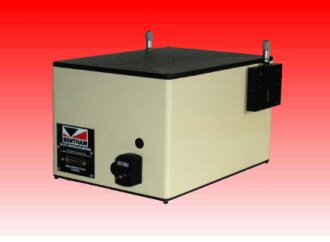
M300 Monochromator
The M300 is a high quality general purpose grating monochromator designed for use the UV, visible and infra-red regions.
The instrument is easily purged for use down to 175nm while a range of easily interchangeable gratings allows operation to 30mm.
A built-in stepping motor and sine drive allow wavelength scanning to be completely controlled from a remote stepping motor drive unit PMC3B. The PMC3B can be controlled from any PC or computer via its IEEE-488 bus interface.
Alternative entrance and exit configurations ensure maximum flexibility of position in integrating spectroscopic systems. The unit is manufactured using a single main casting with rebated lid for optimum light-tightness and stability.
The use of an 1800g/mm grating in the visible region results in a higher resolution and light gathering power than is normally associated with an instrument of this size, while novel and effective internal baffling leads to a particularly low level of scattered light, which is further reduced in the visible region by the use of a holographic grating. The position of the collimating mirrors reduces rediffracted light.
A range of accessories including programmable order sorting filter wheels, detection systems, light sources, integrating spheres, telescopes, reflection/ transmission measurement stations, fibre optic probes and specialised software is available.
Configuration:Symmetrical Czerny Turner with alternative slit positions Focal Length: 300mm
Aperture ratio: F/4.2
Slits: Interchangeable fixed slits, micrometer adjusted, variable or motorised
Order sorting: Unit can be fully order sorted from 200nm to 30µm by using option 252 and Bentham OS series of order sorting filters
Gratings: 69mm2 plane gratings kinematically mounted to allow change-over without loss of calibration.
Maximum resolution obtainable is limited by misfocus in the collimating system. In the HR version, one of the collimating mirrors is mounted on a translation stage allowing fine positioning. All instruments are set up to achieve the specified resolution before delivery.
Stray light (at full aperture with 1nm bandwidth) 1.5 bandwidths from laser line: 0.18%
3.0 bandwidths from laser line: 0.025%
10.0 bandwidths from laser line: 0.004%
Light gathering capability 0.63 = slit height/(f number2 x dispersion) nm/mm
Wavelength scanning By integral stepping motor and microstepping drive electronics
Wavelength readout 4 digit display reading directly in nm with readability of .02nm
Wavelength step Each step of the stepping motor results in a wavelength change of .01nm for the HR version and .05nm for the E version
Maximum scanning speed For 1800 g/mm grating,
M300HR: 4nm/s, M300E: 20nm/s
Wavelength accuracy ±0.2nm of the true throughput range
Dispersion 1.8nm/mm with 1800 grooves/mm grating
PC interface Integral IEEE-488
Power supply Mains input 110/220V 50/60Hz
Weight 12.3kg
Overall dimensions 235mm x 330mm x 192mm high
Construction Single aluminium casting with rebated lid
The instrument is easily purged for use down to 175nm while a range of easily interchangeable gratings allows operation to 30mm.
A built-in stepping motor and sine drive allow wavelength scanning to be completely controlled from a remote stepping motor drive unit PMC3B. The PMC3B can be controlled from any PC or computer via its IEEE-488 bus interface.
Alternative entrance and exit configurations ensure maximum flexibility of position in integrating spectroscopic systems. The unit is manufactured using a single main casting with rebated lid for optimum light-tightness and stability.
The use of an 1800g/mm grating in the visible region results in a higher resolution and light gathering power than is normally associated with an instrument of this size, while novel and effective internal baffling leads to a particularly low level of scattered light, which is further reduced in the visible region by the use of a holographic grating. The position of the collimating mirrors reduces rediffracted light.
A range of accessories including programmable order sorting filter wheels, detection systems, light sources, integrating spheres, telescopes, reflection/ transmission measurement stations, fibre optic probes and specialised software is available.
Specifications (unit fitted with 1800l/mm grating used in first order)
Configuration:Symmetrical Czerny Turner with alternative slit positions Focal Length: 300mm
Aperture ratio: F/4.2
Slits: Interchangeable fixed slits, micrometer adjusted, variable or motorised
Order sorting: Unit can be fully order sorted from 200nm to 30µm by using option 252 and Bentham OS series of order sorting filters
Gratings: 69mm2 plane gratings kinematically mounted to allow change-over without loss of calibration.
Maximum resolution obtainable is limited by misfocus in the collimating system. In the HR version, one of the collimating mirrors is mounted on a translation stage allowing fine positioning. All instruments are set up to achieve the specified resolution before delivery.
Stray light (at full aperture with 1nm bandwidth) 1.5 bandwidths from laser line: 0.18%
3.0 bandwidths from laser line: 0.025%
10.0 bandwidths from laser line: 0.004%
Light gathering capability 0.63 = slit height/(f number2 x dispersion) nm/mm
Wavelength scanning By integral stepping motor and microstepping drive electronics
Wavelength readout 4 digit display reading directly in nm with readability of .02nm
Wavelength step Each step of the stepping motor results in a wavelength change of .01nm for the HR version and .05nm for the E version
Maximum scanning speed For 1800 g/mm grating,
M300HR: 4nm/s, M300E: 20nm/s
Wavelength accuracy ±0.2nm of the true throughput range
Dispersion 1.8nm/mm with 1800 grooves/mm grating
PC interface Integral IEEE-488
Power supply Mains input 110/220V 50/60Hz
Weight 12.3kg
Overall dimensions 235mm x 330mm x 192mm high
Construction Single aluminium casting with rebated lid


